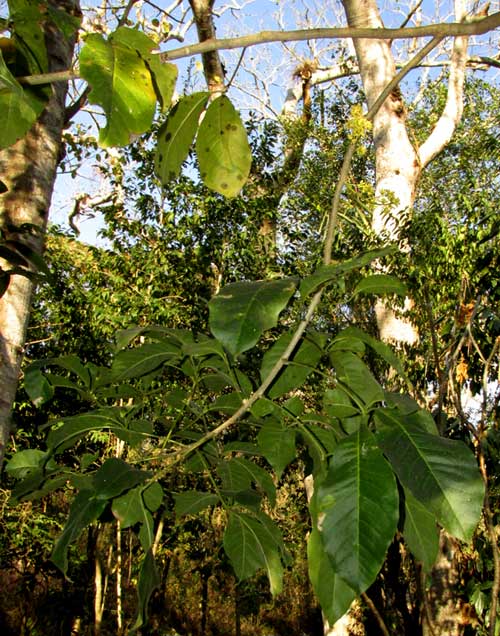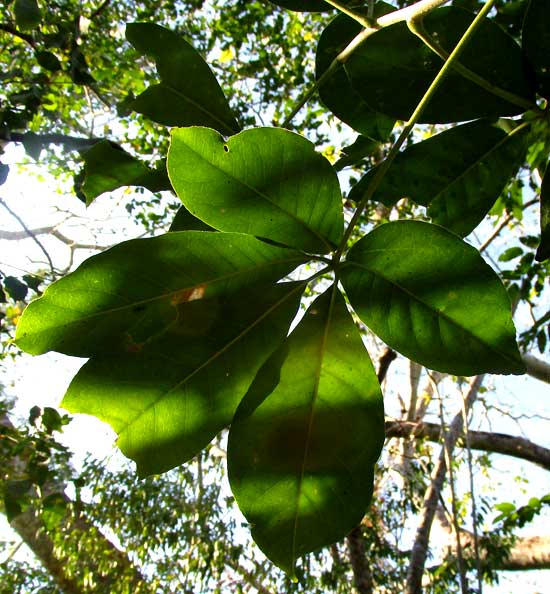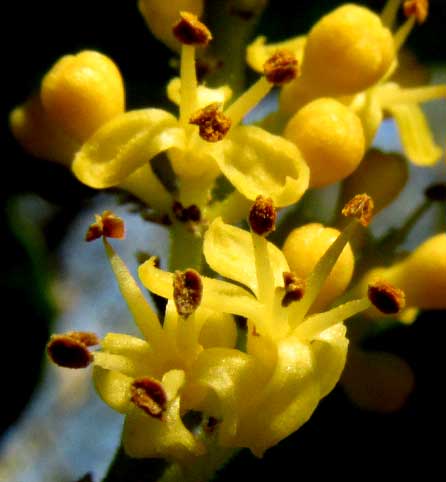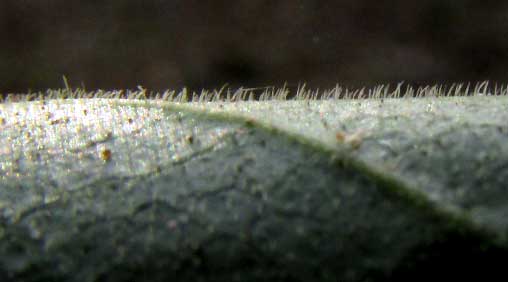Excerpts from Jim Conrad's
Naturalist Newsletter
from the March 13, 2016 Newsletter issued from Hacienda Chichen Resort beside Chichén Itzá Ruins; limestone bedrock; elevation ~39m (~128ft), N20.675°, W88.569°; central Yucatán state, MÉXICO
WOOLY-LEAF WHITE SAPOTE FLOWERING
In the little park beyond the hut where sometimes Maya shamans conduct special ceremonies, wanting to be near the ruins but unable to get any closer, a spindly tree about 15 feet tall (4.5m) in deep shadows bore digitately compound leaves and small, panicle-type clusters of yellowish flowers. Curiously, the flower clusters grew on older parts of branches, often behind the leaves, as shown below in a flash-assisted photo:

The digitately compound leaves -- leaves with leaflets radiating from atop the petiole like "digits" or fingers on a hand -- had caught my eye before the flowers did. A leaf is shown below:

I'd thought that these were the leaves of Fiddlewood, Vitex gaumeri, a species commonly seen in the woods here. You can see the similarity on our Fiddlewood page at www.backyardnature.net/yucatan/vitex.htm
But the small clusters of yellowish flowers just now appearing on this week's tree's branches were very different from Fiddlewood's large, purple blossoms. Here we had something new, and you can see its flowers close up below:

In those pictures I see no female parts. They're unisexual male flowers. This was problematical because I couldn't think of any plant family capable of producing trees with alternate (one leaf per stem node), digitately compound leaves and panicles of small, unisexual flowers.
After several days of false starts finally the name came to me by way of an online interactive key to flowering plant families. The key listed several families I'd already checked, and one family that didn't seem at all right, that of the Citrus Family, the Rutaceae. Digitately compound citrus leaves? Unisexual flowers?
But the list of Rutaceae species found in the Yucatan does indeed include one genus with digitately compound leaves, and that genus is Casimiroa. Our species turned out to be CASIMIROA TETRAMERIA, the Wooly-Leaf White Sapote, in Spanish often called Matasano. This is not the same White Sapote, Casimiroa edulis, whose fruits are much sold in markets, and which is native to the cooler, drier Mexican highlands.
Some literature describes the genus Casimiroa as embracing about 10 species native to Mexico and Central America while others, such as The Rare Fruit Council of Australia, state that the genus consists of "5 doubtfully distinct species confined to Mexico and Central America as far south as Costa Rica." In my attempts to pin down the name Casimiroa tetrameria, I drifted toward the opinion of the Rare Fruit Council, for I couldn't see much difference among the various species. With regard to our tree being known in English as Wooly-leaf White Sapote, our little tree's leaf undersurfaces are indeed velvety-feeling with dense, short hairs, shown below, on the curve of a bent leaf:

White Sapote is described as native to southern Mexico south through most of Central America, and CICY, the Center for Scientific Investigation of the Yucatan, shows the species as present here, but I've not seen it in the local forest, and suspect that in our little park it may have been planted, though it's hard to say.